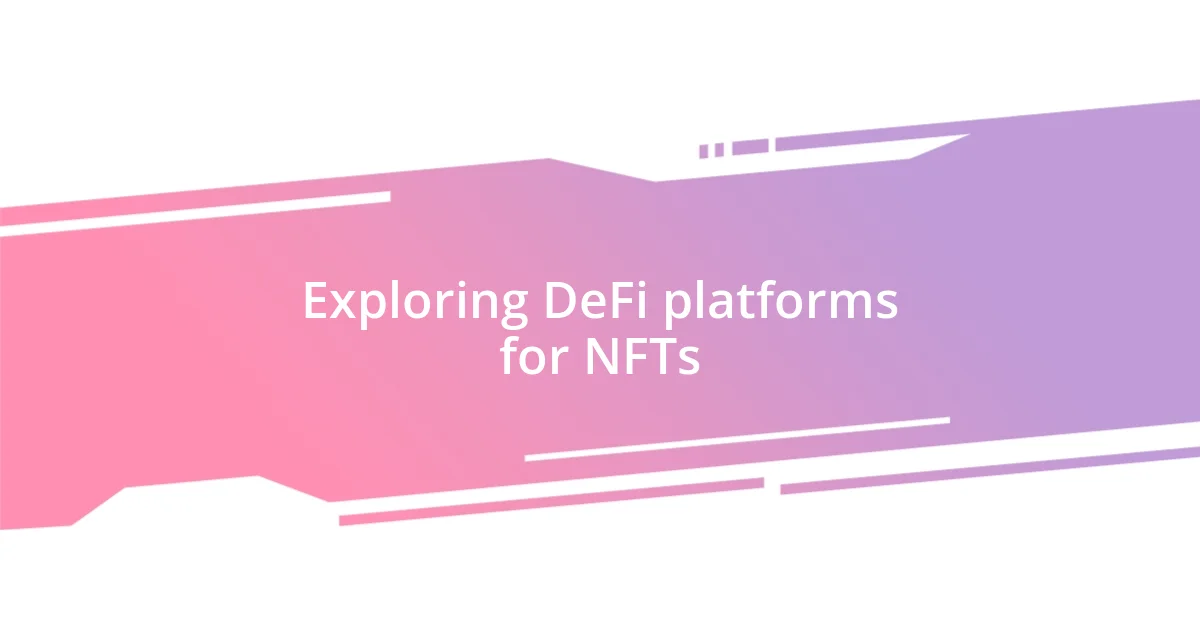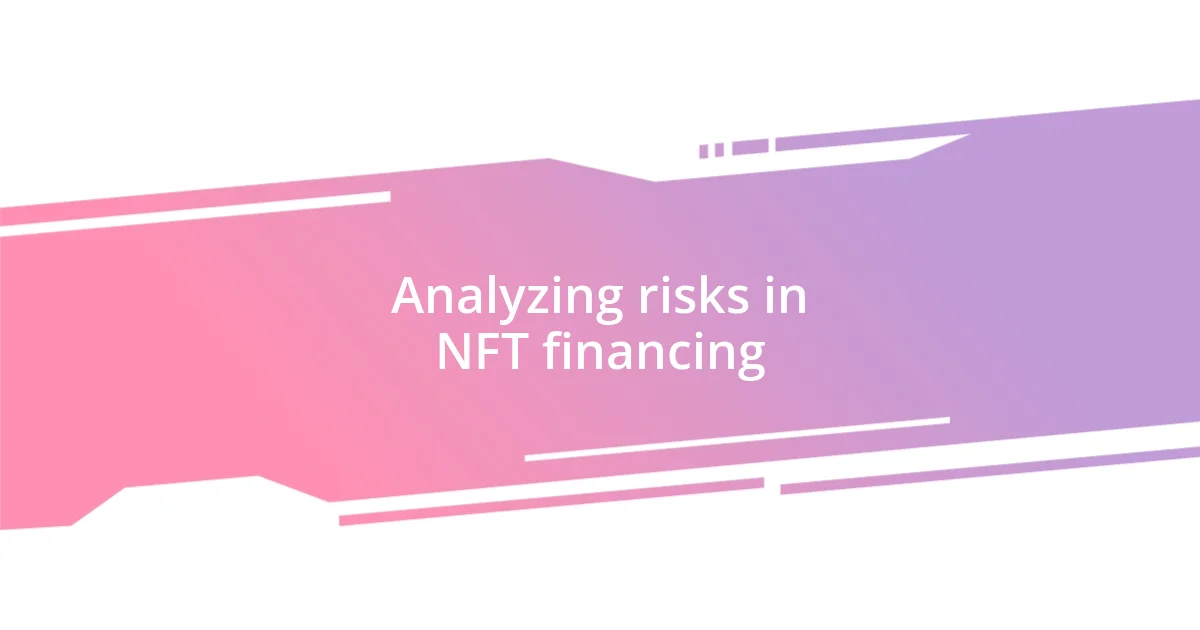Key takeaways:
- Explored diverse NFT financing options, including liquidity pools, NFT-based loans, and fractionalization to optimize digital asset utilization.
- Identified reputable DeFi platforms like Rarible and NFTfi, emphasizing the need for research, diversification, and trend awareness in NFT investments.
- Analyzed risks such as market volatility, liquidity challenges, and potential scams, highlighting the importance of due diligence in making informed investment decisions.

Understanding NFT financing options
When exploring NFT financing options, I found that the landscape is incredibly diverse. For instance, I recently participated in a liquidity pool specifically designed for NFTs, which not only allowed me to leverage my collection but also earn rewards over time—what a win-win situation! Have you ever wondered how people make their digital assets work for them while still enjoying the emotional connections to these unique pieces?
Another option is NFT-based loans, which I’ve personally found to be both intriguing and a bit nerve-wracking. Imagine being able to borrow funds by putting up your digital artwork as collateral—it’s a bit like pawning a treasured piece, isn’t it? During one of my experiences, I felt a rush of anxiety as I weighed the potential loss versus the opportunity to invest further, and it reminded me that with great risk, often comes great reward.
Lastly, fractionalization is a concept that really opened my eyes to the potential of NFT financing. By breaking down a high-value NFT into smaller shares, I could invest in pieces I might have never considered before. This approach made me reflect on the community aspect of ownership—sharing a fraction with others turns a solitary investment into a collective adventure, doesn’t it?

Exploring DeFi platforms for NFTs
When I started diving into DeFi platforms for NFTs, I was amazed by the variety of choices available. One platform that caught my attention was Rarible, where users can not only trade NFTs but also participate in yield farming. I recall setting up my first liquidity pool there, and it felt like unlocking a treasure chest—I was both excited and slightly anxious about how my digital assets would perform. The real-time rewards from providing liquidity were like tiny affirmations of my decision.
Here are some notable DeFi platforms that I explored for NFT financing:
- Rarible: A marketplace that offers liquidity pools for NFT trading, allowing for potential earnings from transactions.
- Aavegotchi: A blend of DeFi and NFTs, enabling users to stake their Aavegotchis and earn rewards while owning unique digital assets.
- NFTfi: A platform dedicated to NFT-backed loans, enabling users to borrow against their NFT collections.
- Fractional.Finance: Specializes in fractionalizing high-value NFTs, making it easier for collectors to invest in expensive pieces collectively.
Each platform brought its own unique flavor to the DeFi experience, reshaping my approach to NFT financing in ways I hadn’t expected.

Strategies for effective NFT investment
When investing in NFTs, I learned the importance of research and due diligence. While browsing through various collections, I found myself gravitating toward projects with strong communities and transparent teams. One time, I missed out on a promising NFT because I hadn’t thoroughly vetted the project’s roadmap and community engagement. Trust me, that taught me the value of double-checking before diving in.
Another strategy I’ve adopted is diversification. I’ve come to appreciate that putting all my eggs in one basket can be risky, especially in the volatile world of NFTs. By spreading my investments across various categories—art, music, virtual real estate, and collectibles—I felt more secure and less vulnerable to market fluctuations. It’s a little like crafting a balanced portfolio but with a creative twist!
Lastly, staying updated with trends and developments in the NFT space can be a game changer. I remember stumbling upon an emerging trend involving utility NFTs, which offered perks like exclusive access to events or content. Understanding such nuances not only helps me make informed decisions but also keeps the excitement alive as I navigate this evolving landscape.
| Strategy | Description |
|---|---|
| Research and Due Diligence | Thoroughly vet projects for community support and credible teams before investing. |
| Diversification | Spread investments across various NFT categories to manage risk. |
| Trend Awareness | Stay updated on emerging trends, such as utility NFTs, to capitalize on new opportunities. |

Analyzing risks in NFT financing
When I think about analyzing risks in NFT financing, several aspects come to mind. The first risk I encountered was market volatility. I recall a time when the value of an NFT I purchased dipped by 30% overnight. It was a gut-wrenching experience that made me realize how quickly the market can shift. This volatility isn’t just a minor inconvenience; it can become a major factor in your financial strategy, affecting both short-term gains and long-term returns.
Another risk lies in the liquidity challenges that NFTs often present. Unlike cryptocurrencies, which can usually be sold quickly, offloading an NFT can take time, especially if it’s a niche item. I learned this lesson when trying to sell a piece that, despite its initial hype, struggled to find a buyer. It got me thinking: how can I ensure my investments have a quick exit strategy? Having a plan for such scenarios is crucial, as I’ve come to understand that not every NFT will find a ready market.
Lastly, the potential for scams or counterfeit assets in the NFT space can’t be overstated. I remember nearly falling prey to a fraudulent project that looked legitimate on the surface. The thrill of chasing after the next big thing can cloud judgment, leading to hasty decisions. This experience taught me the importance of verifying the authenticity of NFTs. I always ask myself: how can I be certain that what I’m investing in is real? Developing a solid process for due diligence ultimately safeguards my interests and reinforces my confidence in this fast-paced market.

Leveraging liquidity pools for NFTs
When I first stumbled into the idea of leveraging liquidity pools for NFTs, it felt like opening a door to a whole new dimension of financing. I remember discovering platforms that allowed me to lock up my NFTs in liquidity pools in exchange for tokens or rewards. This not only provided me with passive income but also ensured that my assets were working for me instead of just sitting in my digital wallet. I often ask myself, why let my NFTs collect dust when they could be generating returns?
Diving deeper into this approach, I encountered some challenges. For instance, there was a moment when I faced uncertainty about impermanent loss—the risk of holding assets that may lose value compared to just holding them. It was a bit nerve-wracking, considering the unique nature of NFTs. This led me to research how specific liquidity pools could mitigate such risks, giving me the confidence to strategize effectively.
Ultimately, the experience of utilizing liquidity pools brought forth an exciting realization: the NFT space is not just about ownership but also about how to leverage that ownership. I recall locking up a prized digital art piece in a pool and watching it contribute to my portfolio’s growth. This dynamic interaction between NFTs and liquidity opens so many doors, and I often think about how it could redefine traditional investment strategies. Isn’t it fascinating to consider how we can evolve our investment techniques to adapt to this shifting landscape?














